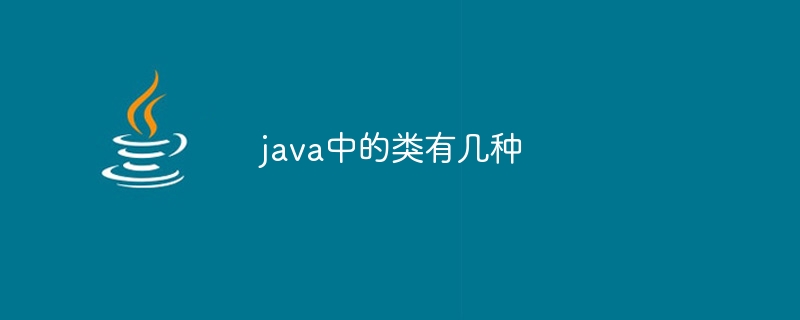How many classes are there in java
Classes in Java are mainly divided into ordinary classes and system classes. Ordinary classes are user-defined, including concrete classes, abstract classes and final classes; system classes are provided by the Java standard library, including predefined classes and internal classes. Ordinary classes are used to encapsulate specific functions and data, abstract classes define public interfaces and abstract methods, the final class implements unchangeable state or behavior, internal classes access members of external classes, and system classes provide core functionality.

Class types in Java
Classes in Java can be roughly divided into two categories:
1. Common class
- ##User-Defined Class: A class created by developers to encapsulate data and Behavior.
- Concrete Class: A class that can be instantiated.
- Abstract Class: A class that cannot be instantiated can only be used as a base class for other classes to inherit.
- Final Class: A class that cannot be inherited.
2. System class
- Predefined Class: Class provided by the Java standard library, For example String
,Integer, andArrayList. - Internal Class (internal class): A class defined inside another class can use members of the external class.
The purpose of each class type
- Common classes: Used to encapsulate specific functions and data of the application.
- Abstract class: Define public interfaces and abstract methods for other classes to inherit and implement.
- Final class: Used to implement unchangeable state or behavior.
- Inner class: Access members of the outer class, such as for callbacks or implementing nested structures.
- System Classes: Provide core functionality and utilities without requiring developers to create their own classes.
The above is the detailed content of How many classes are there in java. For more information, please follow other related articles on the PHP Chinese website!

Hot AI Tools

Undresser.AI Undress
AI-powered app for creating realistic nude photos

AI Clothes Remover
Online AI tool for removing clothes from photos.

Undress AI Tool
Undress images for free

Clothoff.io
AI clothes remover

AI Hentai Generator
Generate AI Hentai for free.

Hot Article

Hot Tools

Notepad++7.3.1
Easy-to-use and free code editor

SublimeText3 Chinese version
Chinese version, very easy to use

Zend Studio 13.0.1
Powerful PHP integrated development environment

Dreamweaver CS6
Visual web development tools

SublimeText3 Mac version
God-level code editing software (SublimeText3)

Hot Topics
 How to use absolute value in c++
May 06, 2024 pm 06:15 PM
How to use absolute value in c++
May 06, 2024 pm 06:15 PM
There are two ways to obtain absolute values in C++: 1. Use the built-in function abs() to obtain the absolute value of an integer or floating point type; 2. Use the generic function std::abs() to obtain various supported absolute values. Operates on absolute values of data types.
 How to use std:: in c++
May 09, 2024 am 03:45 AM
How to use std:: in c++
May 09, 2024 am 03:45 AM
std is the namespace in C++ that contains components of the standard library. In order to use std, use the "using namespace std;" statement. Using symbols directly from the std namespace can simplify your code, but is recommended only when needed to avoid namespace pollution.
 What does prime mean in c++
May 07, 2024 pm 11:33 PM
What does prime mean in c++
May 07, 2024 pm 11:33 PM
prime is a keyword in C++, indicating the prime number type, which can only be divided by 1 and itself. It is used as a Boolean type to indicate whether the given value is a prime number. If it is a prime number, it is true, otherwise it is false.
 How to pop up a window in python
May 05, 2024 pm 08:15 PM
How to pop up a window in python
May 05, 2024 pm 08:15 PM
There are two ways to create popups in Python: Tkinter: Use the Tkinter library to create Tk or TopLevel widgets. Pyglet: Use the Pyglet library to create Window windows.
 What does fabs mean in c++
May 08, 2024 am 01:15 AM
What does fabs mean in c++
May 08, 2024 am 01:15 AM
The fabs() function is a mathematical function in C++ that calculates the absolute value of a floating point number, removes the negative sign and returns a positive value. It accepts a floating point parameter and returns an absolute value of type double. For example, fabs(-5.5) returns 5.5. This function works with floating point numbers, whose accuracy is affected by the underlying hardware.
 _complex usage in c language
May 08, 2024 pm 01:27 PM
_complex usage in c language
May 08, 2024 pm 01:27 PM
The complex type is used to represent complex numbers in C language, including real and imaginary parts. Its initialization form is complex_number = 3.14 + 2.71i, the real part can be accessed through creal(complex_number), and the imaginary part can be accessed through cimag(complex_number). This type supports common mathematical operations such as addition, subtraction, multiplication, division, and modulo. In addition, a set of functions for working with complex numbers is provided, such as cpow, csqrt, cexp, and csin.
 What does config mean in java?
May 07, 2024 am 02:39 AM
What does config mean in java?
May 07, 2024 am 02:39 AM
Config represents configuration information in Java and is used to adjust application behavior. It is usually stored in external files or databases and can be managed through Java Properties, PropertyResourceBundle, Java Configuration Framework or third-party libraries. Its benefits include decoupling and flexibility. , environmental awareness, manageability, scalability.
 How to calculate absolute value in c++
May 06, 2024 pm 06:21 PM
How to calculate absolute value in c++
May 06, 2024 pm 06:21 PM
There are three ways to find the absolute value in C++: Using the abs() function, you can calculate the absolute value of any type of number. Using the std::abs() function, you can calculate the absolute value of integers, floating point numbers, and complex numbers. Manual calculation of absolute values, suitable for simple integers.






